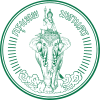SRT Red Lines
| SRT Red Lines | |
|---|---|
 | |
 SRT Light Red Line commuter train at Lak Hok station | |
| Overview | |
| Native name | รถไฟฟ้าชานเมืองสายสีแดง |
| Owner | State Railway of Thailand |
| Locale | Bangkok Metropolitan Region |
| Transit type | Commuter rail |
| Number of lines | |
| Number of stations | 58 (planned) |
| Operation | |
| Began operation | 2 August 2021[1] |
| Operator(s) | S.R.T. Electrified Train Company Limited |
| Character | Elevated |
| Rolling stock | Hitachi AT100 |
| Number of vehicles | 25 EMUs (130 cars); ten 4 car sets and fifteen 6 car sets |
| Technical | |
| System length | 139.3 km (86.56 mi) |
| No. of tracks | 2 |
| Track gauge | 1,000 mm (3 ft 3+3⁄8 in) metre gauge |
| Electrification | 25 kV 50 Hz AC overhead catenary |
| Average speed | 120 km/h (75 mph) |
| Top speed | 160 km/h (99 mph) |
The Red Line Mass Transit System Project is a commuter rail system serving the Bangkok Metropolitan Region in Thailand. Construction began in January 2009, and free public trial operation began on 2 August 2021, when Bang Sue Grand Station opened, with full commercial service starting in November 2021.[2] It is part of the Mass Rapid Transit Master Plan in the Bangkok Metropolitan Region.
Financed through an aid grant from the Japan International Cooperation Agency at a cost of ¥166.9 billion (US$1.6 billion),[3] the system consists of two lines, one (also referred to as the SRT Dark Red Line) running from Thammasat University's Rangsit campus to Maha Chai in Samut Sakhon Province, and the other (SRT Light Red Line) running from Salaya in Nakhon Pathom Province to Hua Mak in Bangkok, with both passing through Bang Sue, which acts as a connecting hub to the Bangkok MRT system.
Most of the railway runs alongside existing national railroad tracks, eventually replacing them. Segments running through inner-city areas are elevated, and the system is electrified by overhead lines. The system was developed and is owned by the State Railway of Thailand.[4][5] Since the Red Lines run roughly along the alignment of the failed Hopewell Project, they have been described as a "Hopewell revival".[6]
See also
[edit]References
[edit]- ^ "สายสีแดงเปิดหวูดฝ่าวิกฤต! "ศักดิ์สยาม" ปิดประตูขาดทุน รฟท.งัดทุกกลยุทธ์ปั้นรายได้-เพิ่มผู้โดยสาร". 2 August 2021.
- ^ bangkokpost. "Free rides along Red Line until November". Bangkok Post. Retrieved 4 August 2021.
- ^ Templeton, Dan (10 October 2016). "Japan finances Bangkok Red Line". International Railway Journal. Retrieved 8 January 2025.
- ^ แผนแม่บทระบบขนส่งมวลชนทางรางในเขตกรุงเทพฯและปริมณฑล พ.ศ.2553-2572 [Mass Rapid Transit Master Plan in Bangkok Metropolitan Region] (PDF) (in Thai). Office of Transport and Traffic Policy and Planning. Archived from the original (PDF) on 15 July 2015. Retrieved 16 January 2012.
- ^ โครงการระบบรถไฟชานเมือง (สายสีแดง) [Commuter rail system project (Red Line)]. SRT website (in Thai). State Railway of Thailand. Retrieved 20 January 2012.
- ^ "Reviving the former Hopewell route", translated and summarized by Wisarut Bholsithi from Prachachart Thurakij, 4–7 March 2004. "This Northern Commuter has to connect with the Airport Link which is not even at the design stage. At the minimum, the detailed design for the Airport Link must be done by July 2004. The Hopewell revival will be an elevated single floor—either shared tracks or separated tracks for High Speed Rail, DMU/Diesel Tracks, and Red Line Commuter which all have to be done in six years. The elevated section will end at Don Muang and then it will be at grade with separated tracks."
External links
[edit]![]() Media related to SRT Red Lines at Wikimedia Commons
Media related to SRT Red Lines at Wikimedia Commons

